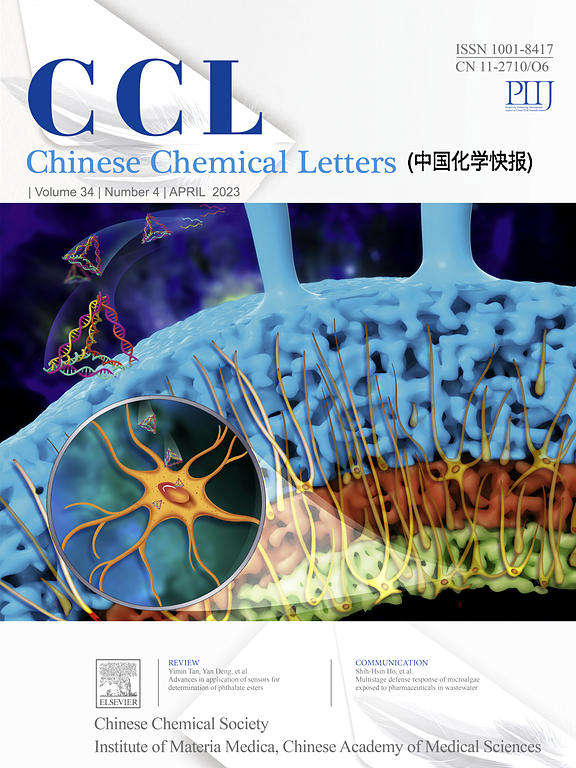Viscosity responsiveness of excited-state dynamics in aggregated-induced emission luminogens
IF 8.9
1区 化学
Q1 CHEMISTRY, MULTIDISCIPLINARY
引用次数: 0
Abstract
Aggregation-induced emission luminogens (AIEgens) exhibit viscosity-responsive behavior resembling those of molecular rotors; however, their response mechanisms are more complex and cannot be adequately described using simple rotational models. AIEgens demonstrate intricate dynamics that are highly dependent on their molecular structures. In this study, we synthesized water-soluble derivatives of representative AIEgens, including tetraphenylethene (TPE), bis(N,N-dialkylamino)anthracene (BDAA), and bridged stilbene, and systematically investigated the dependence of their photophysical properties in water/glycerol mixed solvents on temperature and viscosity. To elucidate the origin of their viscosity responsiveness, quantum chemical calculations were conducted to analyze their potential energy surfaces (PESs). The results revealed that compared to typical molecular rotors, these AIEgens exhibit significantly higher sensitivity to viscosity in low-viscosity regions. Notably, for TPE and BDAA derivatives, the viscosity responsiveness was found to be governed not by the activation energy barrier (ΔEa) based on the PES, but rather by the viscosity-dependent constraints on molecular structural changes. Furthermore, molecules possessing multiple aromatic rings or large, flexible, rotatable moieties were found to exhibit enhanced sensitivity to viscosity due to increased frictional interactions in solutions. This study provides critical insights into the mechanistic origins of the viscosity responsiveness of AIEgens, thereby advancing the fundamental understanding of their behavior and expanding their potential application as viscosity-sensitive probes.

聚集体致发射发光物质激发态动力学的黏度响应性
聚集诱导发射发光原(AIEgens)表现出类似于分子转子的粘度响应行为;然而,它们的反应机制更为复杂,不能用简单的旋转模型来充分描述。细菌表现出高度依赖于其分子结构的复杂动力学。本研究合成了四苯乙烯(TPE)、双(N,N-二氨基)蒽(BDAA)、桥接苯乙烯等具有代表性的AIEgens水溶性衍生物,并系统地研究了它们在水/甘油混合溶剂中的光物理性质对温度和粘度的依赖性。为了阐明其粘度响应性的起源,对其势能面(PESs)进行了量子化学计算。结果表明,与典型的分子转子相比,这些AIEgens在低粘度区域对粘度的敏感性显著提高。值得注意的是,对于TPE和BDAA衍生物,发现粘度响应性不受基于PES的活化能势垒(ΔEa)的控制,而是受分子结构变化的粘度依赖约束。此外,具有多个芳香环或大的、灵活的、可旋转的部分的分子由于溶液中摩擦相互作用的增加而对粘度表现出增强的敏感性。这项研究为AIEgens粘度响应性的机制起源提供了重要的见解,从而推进了对其行为的基本理解,并扩大了其作为粘度敏感探针的潜在应用。
本文章由计算机程序翻译,如有差异,请以英文原文为准。
求助全文
约1分钟内获得全文
求助全文
来源期刊

Chinese Chemical Letters
化学-化学综合
CiteScore
14.10
自引率
15.40%
发文量
8969
审稿时长
1.6 months
期刊介绍:
Chinese Chemical Letters (CCL) (ISSN 1001-8417) was founded in July 1990. The journal publishes preliminary accounts in the whole field of chemistry, including inorganic chemistry, organic chemistry, analytical chemistry, physical chemistry, polymer chemistry, applied chemistry, etc.Chinese Chemical Letters does not accept articles previously published or scheduled to be published. To verify originality, your article may be checked by the originality detection service CrossCheck.
 求助内容:
求助内容: 应助结果提醒方式:
应助结果提醒方式:


